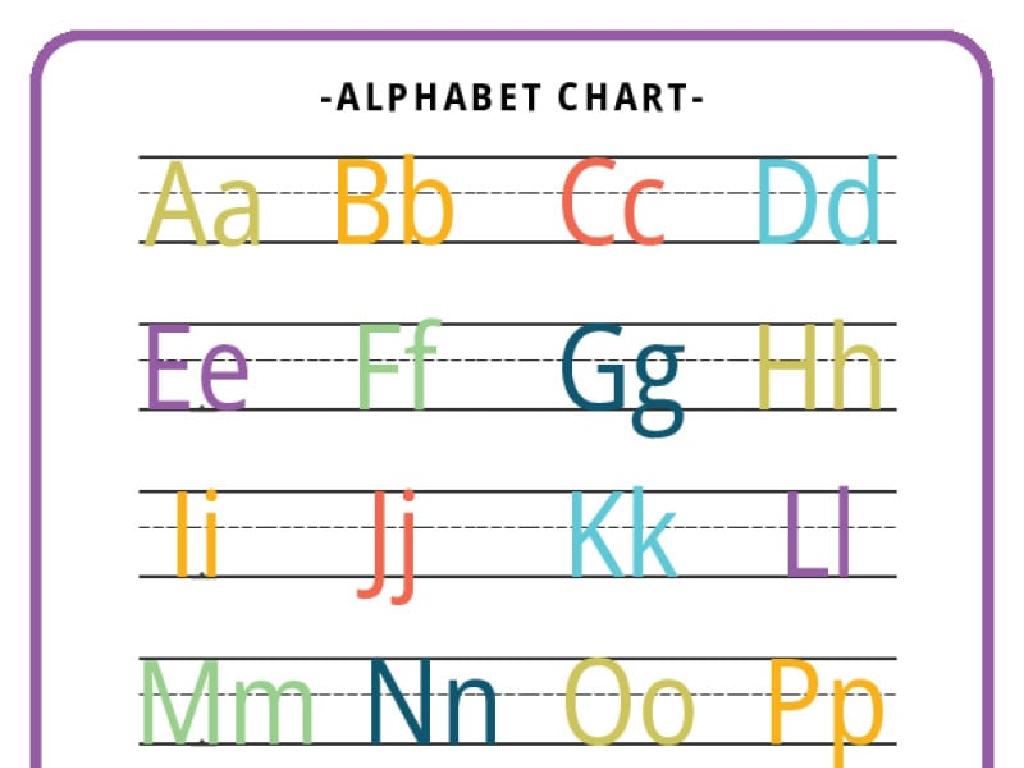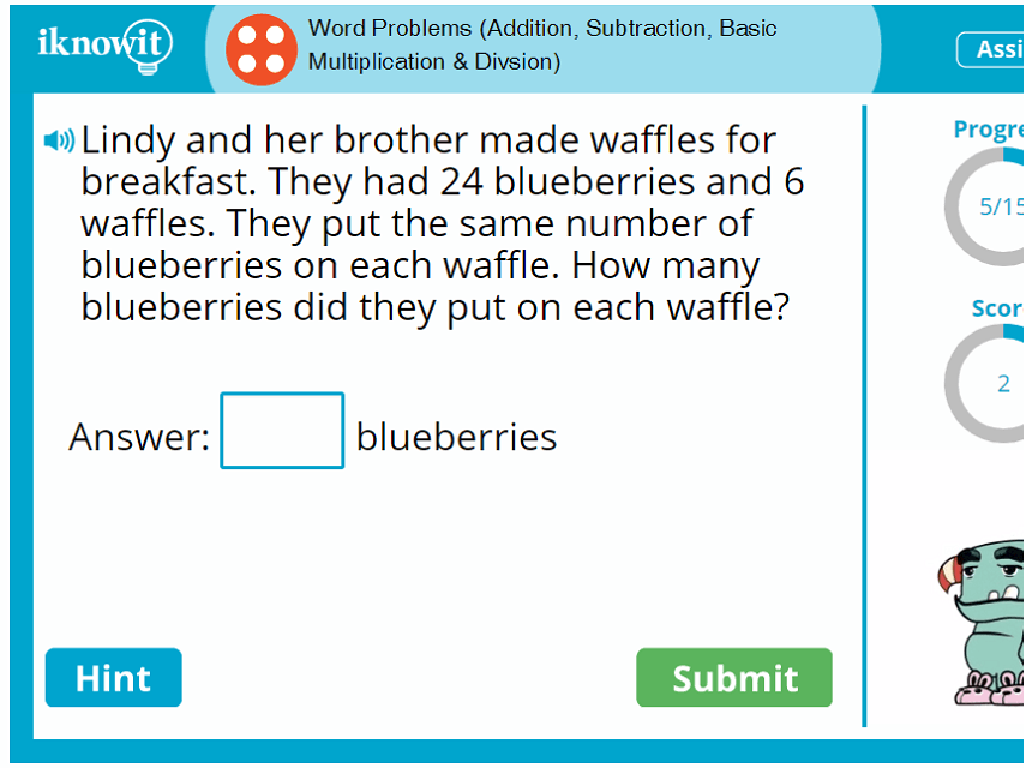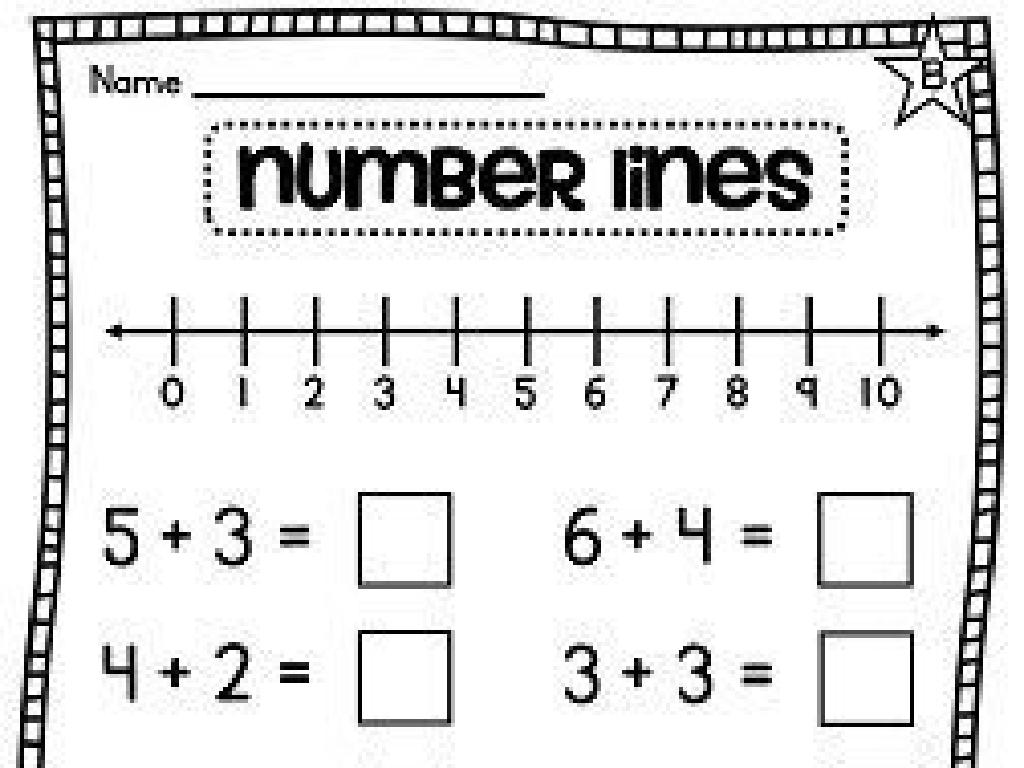Add, Subtract, Multiply, And Divide Money Amounts
Subject: Math
Grade: Fourth grade
Topic: Money
Please LOG IN to download the presentation. Access is available to registered users only.
View More Content
Introduction to Money Math
– Learn about coins and bills
– Identify and value different coins and bills
– Importance of money management
– Managing money helps with saving and spending wisely
– Today’s goal: Master money math
– We’ll learn to add, subtract, multiply, and divide money
– Adding, subtracting, multiplying, dividing
– Use real-life examples like shopping and saving
|
This slide introduces students to the concept of money in a tangible way, using coins and bills to help them understand the value of different denominations. Emphasize the importance of managing money effectively, which is a crucial life skill. The goal for today’s lesson is to ensure students are comfortable with basic arithmetic operations involving money. Provide examples such as calculating change while shopping, figuring out total costs, and understanding how money grows with saving. Encourage students to think of situations where they use money in their daily lives to make the lesson relatable.
Adding Money: Dollars and Cents
– Align decimal points vertically
– Example: $5.75 + $3.20
– When adding, make sure to line up the dollars and cents correctly.
– Class Activity: Add $1.25 + $2.50
– Use this example to practice adding money with the class.
– Discuss results as a class
– We’ll review everyone’s answers and methods together.
|
This slide introduces the concept of adding money, focusing on the importance of aligning decimal points. Start by explaining that just like when adding whole numbers, it’s important to keep the decimal points lined up to ensure dollars are added to dollars and cents to cents. Use the example of $5.75 + $3.20 to demonstrate this concept. Then, engage the class with a hands-on activity where they add $1.25 and $2.50. This will help them apply what they’ve learned. After the activity, discuss the correct method and answer as a class, reinforcing the concept and addressing any misconceptions. Encourage students to ask questions and share their strategies for adding money.
Subtracting Money Amounts
– Align decimal points vertically
– Just like in addition, make sure the decimal points are one under the other.
– Example: Subtract dollars and cents
– If we have $5.00 and spend $2.75, how much do we have left?
– Class practice with $5.00 – $2.75
– Let’s try together: How much money remains after spending $2.75 from $5.00?
|
This slide focuses on teaching students the correct method to subtract money. Emphasize the importance of lining up decimal points to ensure accuracy. Use the example to demonstrate step-by-step subtraction, including dealing with borrowing if necessary. During class practice, guide students through the process of subtracting $2.75 from $5.00, and encourage them to visualize the money to understand the concept better. Provide additional examples if time allows and ensure that each student is comfortable with the process before moving on.
Multiplying Money by Whole Numbers
– Learn to multiply money
– Example: Cost of 3 apples
– If one apple is $0.50, three apples cost 3 x $0.50 = $1.50
– Group Activity: Calculate 4 apples cost
– If one apple costs $0.50, how much for 4? Use multiplication: 4 x $0.50
– Understand practical application
– Applying multiplication to calculate total costs in real-life scenarios
|
This slide introduces students to the concept of multiplying money by whole numbers. Start with an example, such as the price of apples, to show how multiplication is used to find the total cost of multiple items. The group activity involves students working together to calculate the cost of 4 apples, reinforcing the concept through practical application. Ensure that students understand the process of multiplying a money amount by a whole number and can apply this skill in various situations. Encourage them to think of other examples where they might need to multiply money, such as buying supplies for a school project or determining the cost of tickets for a family movie outing.
Dividing Money
– Divide money by whole numbers
– Example: Splitting a bill
– If a $30 bill is split between 3 friends, each pays $10.
– Exercise: Buying a toy
– If a toy costs $10 and you have $2, how many toys can you buy?
– Understanding division with money
– Grasping how division applies to real-life money situations.
|
This slide introduces the concept of dividing money, an essential skill for financial literacy. Start by explaining that dividing money is similar to dividing whole numbers, but we’re dealing with currency. Use the example of splitting a bill to make it relatable. For the individual exercise, guide students to understand that if a toy costs $10 and they have $2, they can’t afford the toy yet, but they can calculate how many $2 payments are needed to reach $10. This exercise helps students apply division to determine the affordability of an item. Encourage students to think of other scenarios where they might need to divide money, such as sharing costs or budgeting an allowance.
Money Math: Shopping Skills
– Using math at the store
– Making exact change
– Counting coins and bills to match the purchase price
– Role-play buying and selling
– Practice with classmates to simulate a store experience
– Understanding transactions
|
This slide introduces students to the practical use of addition, subtraction, multiplication, and division with money through real-life applications like shopping. Emphasize the importance of being able to calculate total costs, determine if they have enough money, and figure out the change they should receive. The role-playing activity will involve students pairing up to act as buyers and sellers, using play money to conduct transactions. This will help them understand the concepts of making purchases and giving exact change. Provide various scenarios with different price points and encourage students to use mental math as well as paper and pencil calculations. This interactive approach aims to build their confidence in handling money in real-world situations.
Class Activity: Money Math Game – ‘Storekeeper’
– Understand ‘Storekeeper’ roles
– Shoppers and cashiers interact
– Shoppers buy items, cashiers total costs
– Practice money math skills
– Add for totals, subtract for change, multiply for multiples, divide for equal payments
– Engage in real-life scenarios
|
This interactive class activity is designed to help students apply their knowledge of adding, subtracting, multiplying, and dividing money in a fun and engaging way. By simulating a store environment, students will take on the roles of shoppers and cashiers. Shoppers will select items to ‘purchase’ and cashiers will calculate the total cost, determine the change required, and even handle bulk purchases or split payments. This activity not only reinforces mathematical concepts but also introduces basic financial literacy skills. Prepare a set of items with price tags and fake currency for the students to use. Consider having different students rotate roles to ensure everyone gets a chance to practice each skill. Possible variations of the activity could include discounts, tax calculations, or handling returns and exchanges.
Great Job on Money Math!
– Proud of your hard work today
– Homework: Money Math Worksheet
– Worksheet includes adding, subtracting, multiplying, and dividing money
– Practice is key to mastery
– The more you practice, the better you’ll get at handling money math
– Keep up the great effort!
|
Today’s class focused on practical money math skills, which are essential for everyday life. For homework, students are assigned a worksheet that covers all the operations we learned today: addition, subtraction, multiplication, and division of money amounts. This will help reinforce their skills and build confidence. Remember to remind students that making mistakes is a part of learning and that with consistent practice, they will improve. Encourage them to try their best and to bring any questions they have to the next class. Offer praise for their efforts and progress.






